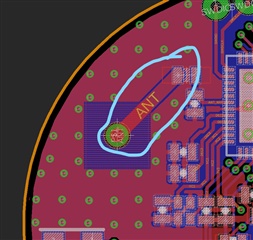Hi,
I am designing a custom PCB with the nRF52832, I am going to use wire bent antenna over it. Can I bend feed wire by 45 degree. I have attached image for the part I am talking about.
Please have a look and let me know about it
.
Hi,
I am designing a custom PCB with the nRF52832, I am going to use wire bent antenna over it. Can I bend feed wire by 45 degree. I have attached image for the part I am talking about.
Please have a look and let me know about it
.
I have redesigned and now it is straight and capacitor is grounded as suggested. Please have a look and let me know about it.
Hi,
Replication of the reference layout is better now, but you should still add a keepout in the top layer around C3 and L1 to avoid the risk of your harmonics getting you in trouble.
As mentioned in another answer, modeling the via and feed would be optimal, but as you might not have the necessary resources on hand it might be better to avoid the number of pitfalls. Regarding the antenna feed, I would remove the square keepout around the feed altogether if you are not able to model it (just having the wire stick right out of the ground plane). As was also mentioned lack of mounting consistency will have an effect on your performance variation, the more variation in your mounting/assembly the more performance will vary between units. Ways to reduce include
Non-idealities such as the antenna protruding the PCB will have an impact on performance, but correct tuning should mitigate most of this if done correctly. This particular antenna is relatively wide-band, and therefore quite forgiving in that respect. Regardless, I expect performance to be fair, and should be sufficient unless you have very high requirements.
I do not know enough about your PCB to know if this is an option or not, but opting for a printed monopole instead yields all the pros of this antenna, but pretty much removes the cons. Of course it requires much more space on the PCB itself. If not an alternative for this board, maybe sometime in the future.
Best regards,
Andreas
Hi,
Replication of the reference layout is better now, but you should still add a keepout in the top layer around C3 and L1 to avoid the risk of your harmonics getting you in trouble.
As mentioned in another answer, modeling the via and feed would be optimal, but as you might not have the necessary resources on hand it might be better to avoid the number of pitfalls. Regarding the antenna feed, I would remove the square keepout around the feed altogether if you are not able to model it (just having the wire stick right out of the ground plane). As was also mentioned lack of mounting consistency will have an effect on your performance variation, the more variation in your mounting/assembly the more performance will vary between units. Ways to reduce include
Non-idealities such as the antenna protruding the PCB will have an impact on performance, but correct tuning should mitigate most of this if done correctly. This particular antenna is relatively wide-band, and therefore quite forgiving in that respect. Regardless, I expect performance to be fair, and should be sufficient unless you have very high requirements.
I do not know enough about your PCB to know if this is an option or not, but opting for a printed monopole instead yields all the pros of this antenna, but pretty much removes the cons. Of course it requires much more space on the PCB itself. If not an alternative for this board, maybe sometime in the future.
Best regards,
Andreas